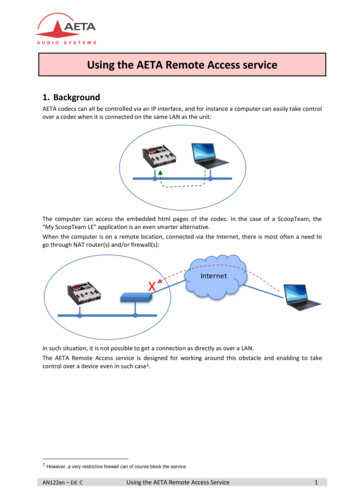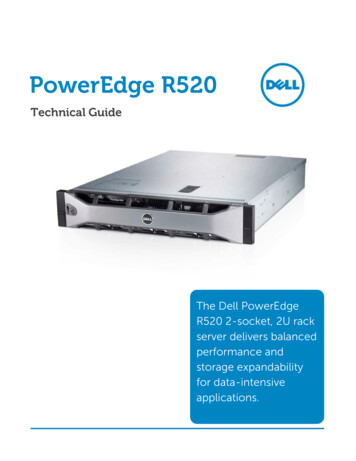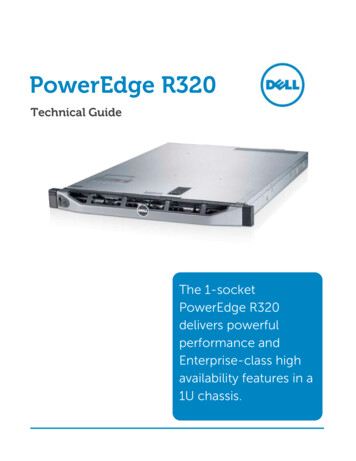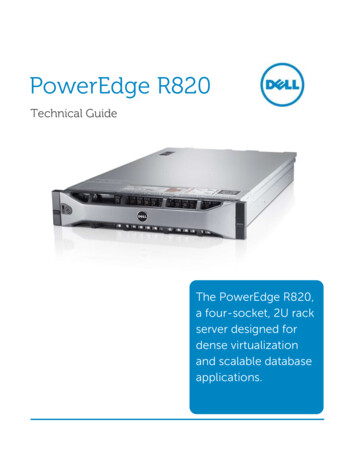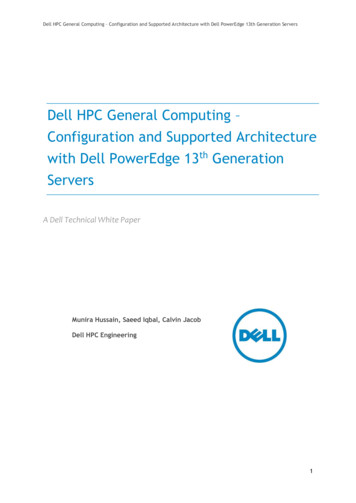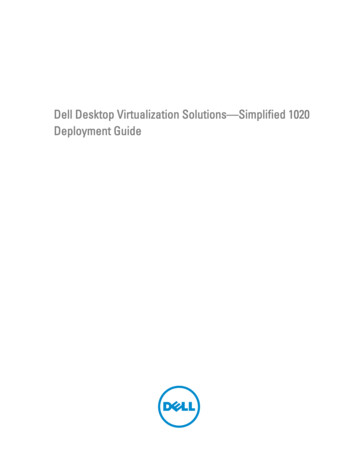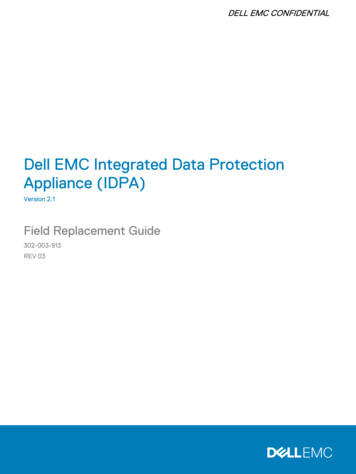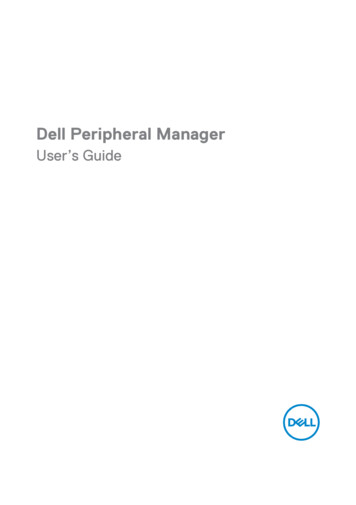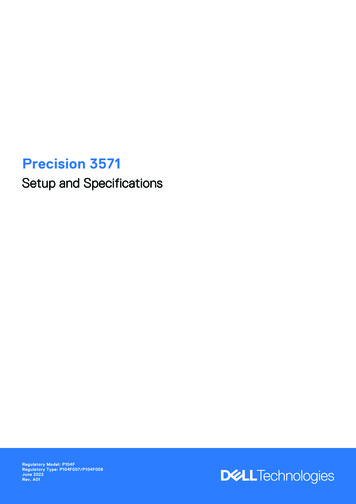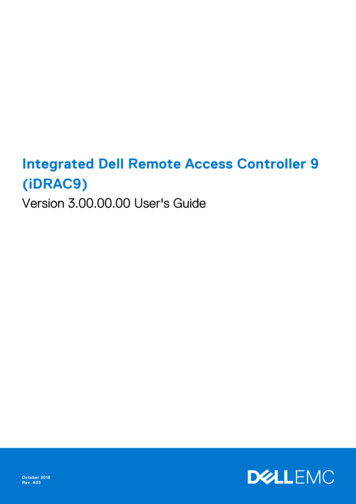
Transcription
Integrated Dell Remote Access Controller 9(iDRAC9)Version 3.00.00.00 User's GuideOctober 2018Rev. A03
Notes, cautions, and warningsNOTE: A NOTE indicates important information that helps you make better use of your product.CAUTION: A CAUTION indicates either potential damage to hardware or loss of data and tells you how to avoidthe problem.WARNING: A WARNING indicates a potential for property damage, personal injury, or death.Copyright 2017 Dell Inc. or its subsidiaries. All rights reserved. Dell, EMC, and other trademarks are trademarks of Dell Inc. or itssubsidiaries. Other trademarks may be trademarks of their respective owners.
ContentsChapter 1: Overview.15Benefits of using iDRAC with Lifecycle Controller. 15Key features. 16New in this release.18How to use this guide. 19Supported web browsers. 19Supported OS and Hypervisors. 19iDRAC licenses .19Types of licenses. 19Methods for acquiring licenses. 20License operations. 20Licensed features in iDRAC9.21Interfaces and protocols to access iDRAC. 26iDRAC port information.28Other documents you may need. 29Contacting Dell. 30Accessing documents from Dell support site. 30Chapter 2: Logging in to iDRAC. 32Logging in to iDRAC as local user, Active Directory user, or LDAP user.32Logging in to iDRAC as a local user using a smart card.33Logging in to iDRAC as an Active Directory user using a smart card.34Logging in to iDRAC using Single Sign-On .34Logging in to iDRAC SSO using iDRAC web interface. 34Logging in to iDRAC SSO using CMC web interface.34Accessing iDRAC using remote RACADM.35Validating CA certificate to use remote RACADM on Linux. 35Accessing iDRAC using local RACADM.35Accessing iDRAC using firmware RACADM. 35Viewing system health. 35Logging in to iDRAC using public key authentication. 36Multiple iDRAC sessions. 36Accessing iDRAC using SMCLP. 37Secure default password. 37Resetting default iDRAC password locally. 37Resetting default iDRAC password remotely. 38Changing the default login password. 39Changing the default login password using web interface. 39Changing the default login password using RACADM. 39Changing the default login password using iDRAC settings utility.39Enabling or disabling default password warning message . 40IP Blocking. 40Enabling or disabling OS to iDRAC Pass-through using web interface.40Enabling or disabling alerts using RACADM.41Contents3
Chapter 3: Setting up managed system. 42Setting up iDRAC IP address.42Setting up iDRAC IP using iDRAC settings utility. 43Setting up iDRAC IP using the CMC web interface.45Enabling provisioning server. 46Configuring servers and server components using Auto Config. 46Using hash passwords for improved security.51Modifying local administrator account settings.53Setting up managed system location. 53Setting up managed system location using web interface.53Setting up managed system location using RACADM.53Setting up managed system location using iDRAC settings utility.54Optimizing system performance and power consumption.54Modifying thermal settings using iDRAC web interface. 54Modifying thermal settings using RACADM. 55Modifying thermal settings using iDRAC settings utility.59Setting up management station. 60Accessing iDRAC remotely.60Configuring supported web browsers. 60Configuring Internet Explorer.60Configuring Mozilla Firefox. 61Configuring web browsers to use virtual console. 62Viewing localized versions of web interface.65Updating device firmware. 65Updating firmware using iDRAC web interface.67Updating device firmware using RACADM. 68Scheduling automatic firmware updates. 69Updating firmware using CMC web interface. 70Updating firmware using DUP. 70Updating firmware using remote RACADM. 71Updating firmware using Lifecycle Controller Remote Services. 71Updating CMC firmware from iDRAC. 71Viewing and managing staged updates.72Viewing and managing staged updates using iDRAC web interface. 72Viewing and managing staged updates using RACADM. 72Rolling back device firmware. 72Rollback firmware using iDRAC web interface. 73Rollback firmware using CMC web interface.73Rollback firmware using RACADM. 73Rollback firmware using Lifecycle Controller.74Rollback firmware using Lifecycle Controller-Remote Services. 74Recovering iDRAC. 74Backing up server profile. 74Backing up server profile using iDRAC web interface. 75Backing up server profile using RACADM. 75Scheduling automatic backup server profile. 75Importing server profile.76Importing server profile using iDRAC web interface. 77Importing server profile using RACADM. 774Contents
Restore operation sequence. 77Monitoring iDRAC using other Systems Management tools.78Support Server Configuration Profile (SCP) — Import and Export .78Secure Boot Configuration from BIOS Settings (F2).78Chapter 4: Configuring iDRAC. 80Viewing iDRAC information.81Viewing iDRAC information using web interface. 81Viewing iDRAC information using RACADM. 82Modifying network settings. 82Modifying network settings using web interface. 82Modifying network settings using local RACADM. 82Configuring IP filtering. 83FIPS mode.84Enabling FIPS Mode.84Disabling FIPS mode. 85Configuring services. 85Configuring services using web interface. 85Configuring services using RACADM. 85Enabling or disabling HTTPS redirection. 86Configuring TLS.86Configuring TLS using web interface. 86Configuring TLS using RACADM. 86Using VNC client to manage remote server. 87Configuring VNC server using iDRAC web interface.87Configuring VNC server using RACADM. 87Setting up VNC viewer with SSL encryption.87Setting up VNC viewer without SSL encryption. 88Configuring front panel display. 88Configuring LCD setting. 88Configuring system ID LED setting. 89Configuring time zone and NTP. 89Configuring time zone and NTP using iDRAC web interface. 90Configuring time zone and NTP using RACADM.90Setting first boot device.90Setting first boot device using web interface. 90Setting first boot device using RACADM.91Setting first boot device using virtual console.91Enabling last crash screen. 91Enabling or disabling OS to iDRAC Pass-through. 91Supported cards for OS to iDRAC Pass-through .92Supported operating systems for USB NIC. 92Enabling or disabling OS to iDRAC Pass-through using web interface.93Enabling or disabling OS to iDRAC Pass-through using RACADM.94Enabling or disabling OS to iDRAC Pass-through using iDRAC settings utility.94Obtaining certificates.94SSL server certificates. 95Generating a new certificate signing request. 96Uploading server certificate. 96Viewing server certificate.97Contents5
Uploading custom signing certificate.97Downloading custom SSL certificate signing certificate .98Deleting custom SSL certificate signing certificate.98Configuring multiple iDRACs using RACADM.98Disabling access to modify iDRAC configuration settings on host system.99Chapter 5: Viewing iDRAC and managed system information. 100Viewing managed system health and properties. 100Viewing system inventory.100Viewing sensor information.101Monitoring performance index of CPU, memory, and input output modules. 102Monitoring performance index of CPU, memory, and input output modules using web interface.103Monitoring performance index for of CPU, memory, and input output modules using RACADM. 104Checking the system for Fresh Air compliance.104Viewing historical temperature data. 104Viewing historical temperature data using iDRAC web interface. 105Viewing historical temperature data using RACADM. 105Configuring warning threshold for inlet temperature. 105Viewing network interfaces available on host OS. 105Viewing network interfaces available on host OS using web interface.106Viewing network interfaces available on host OS using RACADM.106Viewing FlexAddress mezzanine card fabric connections. 106Viewing or terminating iDRAC sessions.107Terminating iDRAC sessions using web interface.107Chapter 6: Setting up iDRAC communication. 108Communicating with iDRAC through serial connection using DB9 cable. 109Configuring BIOS for serial connection. 109Enabling RAC serial connection.109Enabling IPMI serial connection basic and terminal modes. 110Switching between RAC serial and serial console while using DB9 cable. 112Switching from serial console to RAC serial. 112Switching from RAC serial to serial console. 112Communicating with iDRAC using IPMI SOL.112Configuring BIOS for serial connection. 112Configuring iDRAC to use SOL.113Enabling supported protocol. 114Communicating with iDRAC using IPMI over LAN.117Configuring IPMI over LAN using web interface.118Configuring IPMI over LAN using iDRAC settings utility.118Configuring IPMI over LAN using RACADM.118Enabling or disabling remote RACADM. 118Enabling or disabling remote RACADM using web interface. 119Enabling or disabling remote RACADM using RACADM. 119Disabling local RACADM. 119Enabling IPMI on managed system. 119Configuring Linux for serial console during boot in RHEL 6. 119Enabling login to the virtual console after boot. 120Supported SSH cryptography schemes.1216Contents
Using public key authentication for SSH.122Chapter 7: Configuring user accounts and privileges.125Recommended characters in user names and passwords. 125Configuring local users. 126Configuring local users using iDRAC web interface. 126Configuring local users using RACADM.126Configuring Active Directory users.
Restore operation sequence.77


